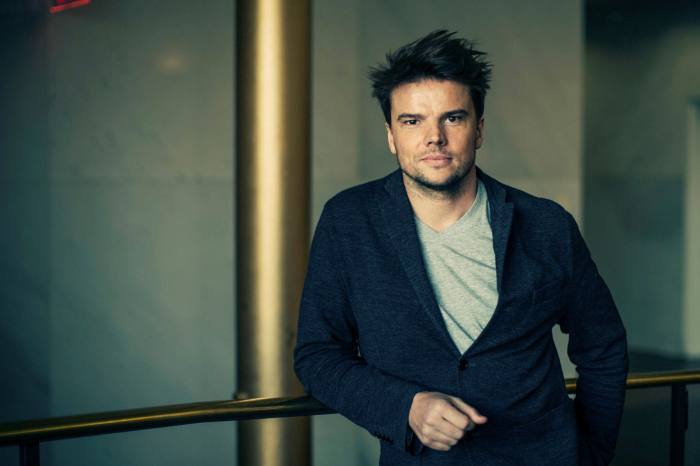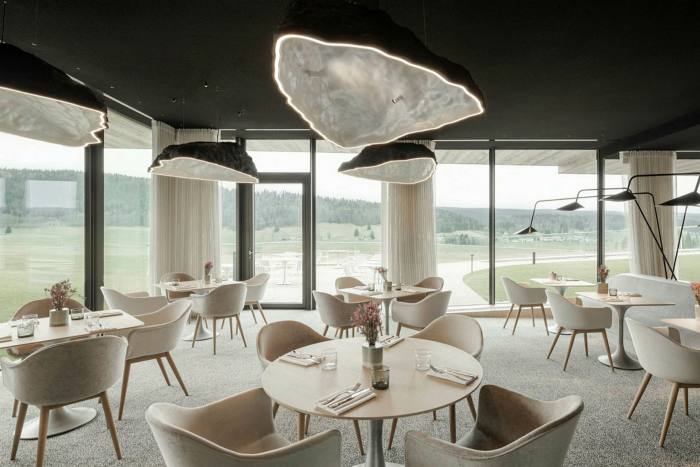A watch by Audemars Piguet (AP) is rarely designed to be discreet. It is a symbol, intended to be visible — a piece of ostentatious jewellery justified by the craft, workmanship, technical wonder, and invention that it embodies as a functional, rather than a decorative, object.
You might expect then, a hotel designed for AP by a starchitect — Denmark’s Bjarke Ingels — to be a similarly visible and high-tech affair. You would be disappointed.
The new Hôtel des Horlogers in the birthplace and nexus of Swiss watchmaking, the Vallée de Joux, does not even have a sign. Set back from the street behind a grass meadow in the village of Le Brassus, its low-slung, timber and glass facade displays little of the self-conscious luxe of watches that might be made of solid rose gold and retail for hundreds of thousands of pounds.
“The story of how watchmaking started here is fascinating,” Ingels tells me. In 1541, Geneva instituted Protestant reformer John Calvin’s ban on wearing jewellery. “But, because watchmaking was seen as an applied art, it fell outside the regulations and the goldsmiths transferred their skills to clocks.”

That story is supplemented by one just as quirky. The people in the valley, mostly cattle-farmers — many of them Huguenot refugees from France — had little to do in the winter when the valley was snowed in, the roads inaccessible and the schools shuttered. So they took to their attics and began crafting watch parts. Le Brassus’ most prominent buildings are still the AP head office and the Laiterie, with its shiny metal milk churns stacked outside.
The landscape was intimately connected to everyday life, here. When Ingels and his practice, the Bjarke Ingels Group (BIG), came to design the hotel, they made efforts to embed the building in the terrain, even to supplement it by envisaging its eccentric vertical ramps as a landscape within the landscape.

This is a modus operandi for Ingels, whose famous buildings include Amager Bakke, a waste incinerator in Copenhagen with a ski-slope on top, and a pyramidal mountain of a skyscraper, Via 57 West, in West Manhattan. They reflect a desire to create a landscape from, rather than just outside, the architecture, which perhaps stems from the flatness of Denmark. He cannot seem to resist it.
The hotel itself is slick and generous, from the lobby with its stripped tree roots hanging from the ceiling and its unfurled ammonite of a reception desk, to Le Gogant — the restaurant downstairs run by three Michelin star chef Emmanuel Renaut. This is an operation which looks well-engineered and runs, of course, like clockwork.

The interiors, designed by French agency AUM Pierre Minassian, attempt to echo elements of the landscape, from strange truffle-shaped light fittings to mountains inscribed on the walls in silvery op-art discs. It is occasionally a little much — the white elephant-ear light fittings looming over the beds can be a bit oppressive, making the interior at odds with what is, by Ingels’ standards, a relatively understated building.
General manager André Cheminade tells me that this is already becoming “a place of architectural, as well as horological, pilgrimage”. BIG designed the AP Museum next door — another building set deep into the earth and virtually invisible form the main road — so visitors get a two-for-one experience.
Ingels describes the design of the museum to me as “a spiral that takes you to the centre and unwinds again or, if you like, you can jump in time across the space.” He points out that, in watches, “miniaturisation is making things smaller and thinner, and skeletonisation removes plates and reveals the inner workings — the performance of the mechanism becomes the whole story.” So he went and removed everything he could. “The solid elements, the walls and the columns have been eliminated and the spiral mechanism revealed. It’s architecture as clockwork.”

The way he achieved this was to make curved walls of structural glass; the workings of the interior are visible from the valley and the landscape is ever-present inside. Vitrines containing unimaginably precious timepieces spanning the history of watchmaking clam up into black monoliths after closing, watchmakers can be seen in an atelier inside the building working at almost infinitesimally small scales, their labour visible, their actual actions and the microscopic screws and cogs they work with, remaining unseen. The whole thing is wrapped in a delicate bronze mesh, a net to contain the parts.
I could not help asking Ingels, rarely the subtlest and most self-effacing of architects, why these buildings, but particularly the museum, were made almost invisible. “The museum site was between two older buildings,” he says, “and it would have looked like we were a newcomer in between two old friends.”
Le Brassus has become a bit of construction site. These two structures may be complete but a new AP factory is being built along the winding mountain stream. Red tower cranes punctuate the sleepy skyline incongruously, competing only with church spires and the occasional oversized pine.
It is a curious kind of destination, with skiing and forest hiking as attractions besides watches, but it is also an emerging landscape of luxury. Watch and clock maker Jaeger-LeCoultre has its own museum nearby and the independent Espace Horloger in Le Sentier, four kilometres from Le Brassus, gives a fine historic overview of Swiss watchmaking. Blancpain and Breguet, inventors of the shock-absorbers that made watches more durable and practical, are here, too.
Ingels, of course, wears an AP on his wrist. “It’s an exposed escapement, and sometimes, when I’m sitting around, it feels a little like another pulse,” he says. “The clockwork captures energy from my movement and uses it. You take a lot of inanimate gears and springs and then harvest your energy to make an almost lifelike state.”
In a way, it is exactly what he has done with the landscape: harnessing the views, the potential, the movement of the sky and the grass, and using it to animate the interiors of the new hotel. Like the cowbells echoing the chimes of the church clocks, and AP’s incredibly-engineered minute-repeater chiming watches, its architecture is a capturing of the tension between movement, energy and the seemingly inanimate nature of materials.
Stay connected with us on social media platform for instant update click here to join our Twitter, & Facebook
We are now on Telegram. Click here to join our channel (@TechiUpdate) and stay updated with the latest Technology headlines.
For all the latest Travel News Click Here
